Business Valuation Report: Analysis of Sultania's Article
VerifiedAdded on 2021/05/31
|11
|2844
|97
Report
AI Summary
This report analyzes the article "Business Valuation Is Not Just A Number, It's A Story" by Sneha Sultania, which emphasizes the often-overlooked importance of business valuation for companies. The report highlights the key issues raised in the article, including the lack of awareness among business owners regarding the value of their ventures and the perception that valuation is only needed when selling. The report discusses the need for business valuation in various scenarios like share swaps, restructuring, and tax planning. It explores the factors to be considered during valuation, such as the objective of the valuation and the micro and macro perspectives of the business. The report outlines the income technique, market approach, and rules of thumb as methods of business valuation, while also providing an evaluation of the article's strengths and weaknesses. It concludes with an opinion on the importance of regular business valuation and the potential disadvantages of delaying the process. The report emphasizes the importance of understanding different valuation approaches and making informed decisions about which method to use.

Running head: BUSINESS VALUATION
1
Business Valuation
Student’s name
Professor
Course
Date
1
Business Valuation
Student’s name
Professor
Course
Date
Paraphrase This Document
Need a fresh take? Get an instant paraphrase of this document with our AI Paraphraser
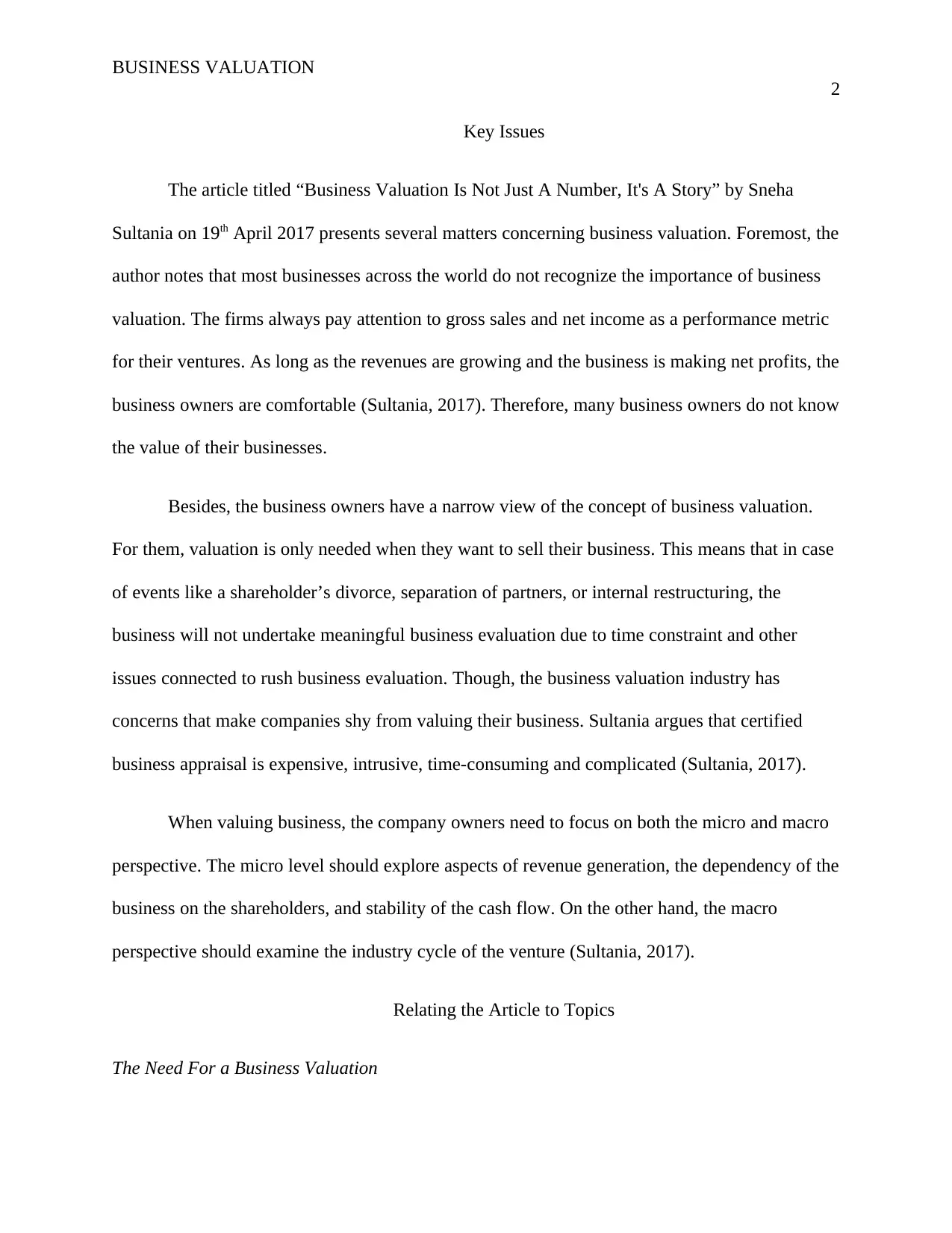
BUSINESS VALUATION
2
Key Issues
The article titled “Business Valuation Is Not Just A Number, It's A Story” by Sneha
Sultania on 19th April 2017 presents several matters concerning business valuation. Foremost, the
author notes that most businesses across the world do not recognize the importance of business
valuation. The firms always pay attention to gross sales and net income as a performance metric
for their ventures. As long as the revenues are growing and the business is making net profits, the
business owners are comfortable (Sultania, 2017). Therefore, many business owners do not know
the value of their businesses.
Besides, the business owners have a narrow view of the concept of business valuation.
For them, valuation is only needed when they want to sell their business. This means that in case
of events like a shareholder’s divorce, separation of partners, or internal restructuring, the
business will not undertake meaningful business evaluation due to time constraint and other
issues connected to rush business evaluation. Though, the business valuation industry has
concerns that make companies shy from valuing their business. Sultania argues that certified
business appraisal is expensive, intrusive, time-consuming and complicated (Sultania, 2017).
When valuing business, the company owners need to focus on both the micro and macro
perspective. The micro level should explore aspects of revenue generation, the dependency of the
business on the shareholders, and stability of the cash flow. On the other hand, the macro
perspective should examine the industry cycle of the venture (Sultania, 2017).
Relating the Article to Topics
The Need For a Business Valuation
2
Key Issues
The article titled “Business Valuation Is Not Just A Number, It's A Story” by Sneha
Sultania on 19th April 2017 presents several matters concerning business valuation. Foremost, the
author notes that most businesses across the world do not recognize the importance of business
valuation. The firms always pay attention to gross sales and net income as a performance metric
for their ventures. As long as the revenues are growing and the business is making net profits, the
business owners are comfortable (Sultania, 2017). Therefore, many business owners do not know
the value of their businesses.
Besides, the business owners have a narrow view of the concept of business valuation.
For them, valuation is only needed when they want to sell their business. This means that in case
of events like a shareholder’s divorce, separation of partners, or internal restructuring, the
business will not undertake meaningful business evaluation due to time constraint and other
issues connected to rush business evaluation. Though, the business valuation industry has
concerns that make companies shy from valuing their business. Sultania argues that certified
business appraisal is expensive, intrusive, time-consuming and complicated (Sultania, 2017).
When valuing business, the company owners need to focus on both the micro and macro
perspective. The micro level should explore aspects of revenue generation, the dependency of the
business on the shareholders, and stability of the cash flow. On the other hand, the macro
perspective should examine the industry cycle of the venture (Sultania, 2017).
Relating the Article to Topics
The Need For a Business Valuation
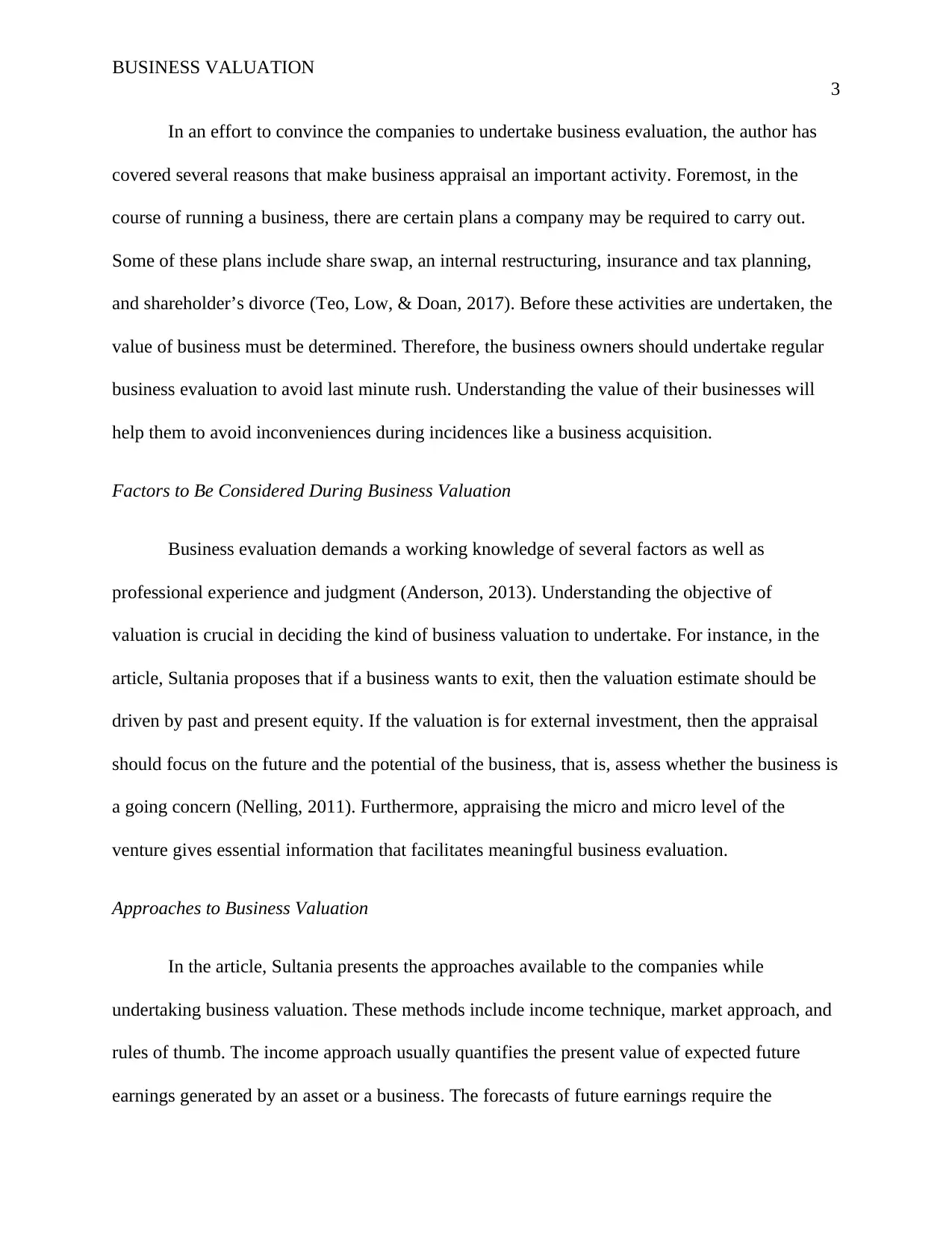
BUSINESS VALUATION
3
In an effort to convince the companies to undertake business evaluation, the author has
covered several reasons that make business appraisal an important activity. Foremost, in the
course of running a business, there are certain plans a company may be required to carry out.
Some of these plans include share swap, an internal restructuring, insurance and tax planning,
and shareholder’s divorce (Teo, Low, & Doan, 2017). Before these activities are undertaken, the
value of business must be determined. Therefore, the business owners should undertake regular
business evaluation to avoid last minute rush. Understanding the value of their businesses will
help them to avoid inconveniences during incidences like a business acquisition.
Factors to Be Considered During Business Valuation
Business evaluation demands a working knowledge of several factors as well as
professional experience and judgment (Anderson, 2013). Understanding the objective of
valuation is crucial in deciding the kind of business valuation to undertake. For instance, in the
article, Sultania proposes that if a business wants to exit, then the valuation estimate should be
driven by past and present equity. If the valuation is for external investment, then the appraisal
should focus on the future and the potential of the business, that is, assess whether the business is
a going concern (Nelling, 2011). Furthermore, appraising the micro and micro level of the
venture gives essential information that facilitates meaningful business evaluation.
Approaches to Business Valuation
In the article, Sultania presents the approaches available to the companies while
undertaking business valuation. These methods include income technique, market approach, and
rules of thumb. The income approach usually quantifies the present value of expected future
earnings generated by an asset or a business. The forecasts of future earnings require the
3
In an effort to convince the companies to undertake business evaluation, the author has
covered several reasons that make business appraisal an important activity. Foremost, in the
course of running a business, there are certain plans a company may be required to carry out.
Some of these plans include share swap, an internal restructuring, insurance and tax planning,
and shareholder’s divorce (Teo, Low, & Doan, 2017). Before these activities are undertaken, the
value of business must be determined. Therefore, the business owners should undertake regular
business evaluation to avoid last minute rush. Understanding the value of their businesses will
help them to avoid inconveniences during incidences like a business acquisition.
Factors to Be Considered During Business Valuation
Business evaluation demands a working knowledge of several factors as well as
professional experience and judgment (Anderson, 2013). Understanding the objective of
valuation is crucial in deciding the kind of business valuation to undertake. For instance, in the
article, Sultania proposes that if a business wants to exit, then the valuation estimate should be
driven by past and present equity. If the valuation is for external investment, then the appraisal
should focus on the future and the potential of the business, that is, assess whether the business is
a going concern (Nelling, 2011). Furthermore, appraising the micro and micro level of the
venture gives essential information that facilitates meaningful business evaluation.
Approaches to Business Valuation
In the article, Sultania presents the approaches available to the companies while
undertaking business valuation. These methods include income technique, market approach, and
rules of thumb. The income approach usually quantifies the present value of expected future
earnings generated by an asset or a business. The forecasts of future earnings require the
⊘ This is a preview!⊘
Do you want full access?
Subscribe today to unlock all pages.

Trusted by 1+ million students worldwide
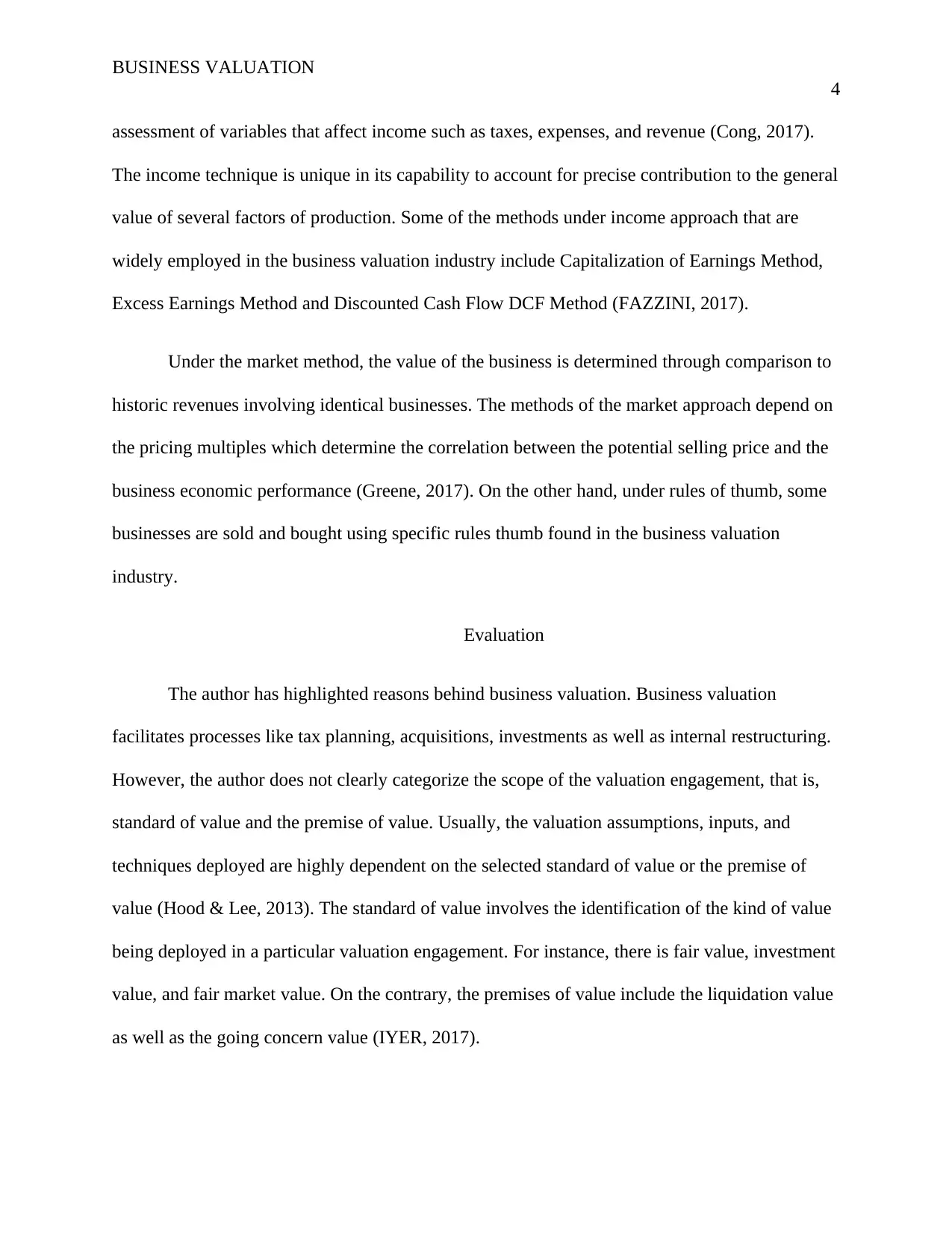
BUSINESS VALUATION
4
assessment of variables that affect income such as taxes, expenses, and revenue (Cong, 2017).
The income technique is unique in its capability to account for precise contribution to the general
value of several factors of production. Some of the methods under income approach that are
widely employed in the business valuation industry include Capitalization of Earnings Method,
Excess Earnings Method and Discounted Cash Flow DCF Method (FAZZINI, 2017).
Under the market method, the value of the business is determined through comparison to
historic revenues involving identical businesses. The methods of the market approach depend on
the pricing multiples which determine the correlation between the potential selling price and the
business economic performance (Greene, 2017). On the other hand, under rules of thumb, some
businesses are sold and bought using specific rules thumb found in the business valuation
industry.
Evaluation
The author has highlighted reasons behind business valuation. Business valuation
facilitates processes like tax planning, acquisitions, investments as well as internal restructuring.
However, the author does not clearly categorize the scope of the valuation engagement, that is,
standard of value and the premise of value. Usually, the valuation assumptions, inputs, and
techniques deployed are highly dependent on the selected standard of value or the premise of
value (Hood & Lee, 2013). The standard of value involves the identification of the kind of value
being deployed in a particular valuation engagement. For instance, there is fair value, investment
value, and fair market value. On the contrary, the premises of value include the liquidation value
as well as the going concern value (IYER, 2017).
4
assessment of variables that affect income such as taxes, expenses, and revenue (Cong, 2017).
The income technique is unique in its capability to account for precise contribution to the general
value of several factors of production. Some of the methods under income approach that are
widely employed in the business valuation industry include Capitalization of Earnings Method,
Excess Earnings Method and Discounted Cash Flow DCF Method (FAZZINI, 2017).
Under the market method, the value of the business is determined through comparison to
historic revenues involving identical businesses. The methods of the market approach depend on
the pricing multiples which determine the correlation between the potential selling price and the
business economic performance (Greene, 2017). On the other hand, under rules of thumb, some
businesses are sold and bought using specific rules thumb found in the business valuation
industry.
Evaluation
The author has highlighted reasons behind business valuation. Business valuation
facilitates processes like tax planning, acquisitions, investments as well as internal restructuring.
However, the author does not clearly categorize the scope of the valuation engagement, that is,
standard of value and the premise of value. Usually, the valuation assumptions, inputs, and
techniques deployed are highly dependent on the selected standard of value or the premise of
value (Hood & Lee, 2013). The standard of value involves the identification of the kind of value
being deployed in a particular valuation engagement. For instance, there is fair value, investment
value, and fair market value. On the contrary, the premises of value include the liquidation value
as well as the going concern value (IYER, 2017).
Paraphrase This Document
Need a fresh take? Get an instant paraphrase of this document with our AI Paraphraser
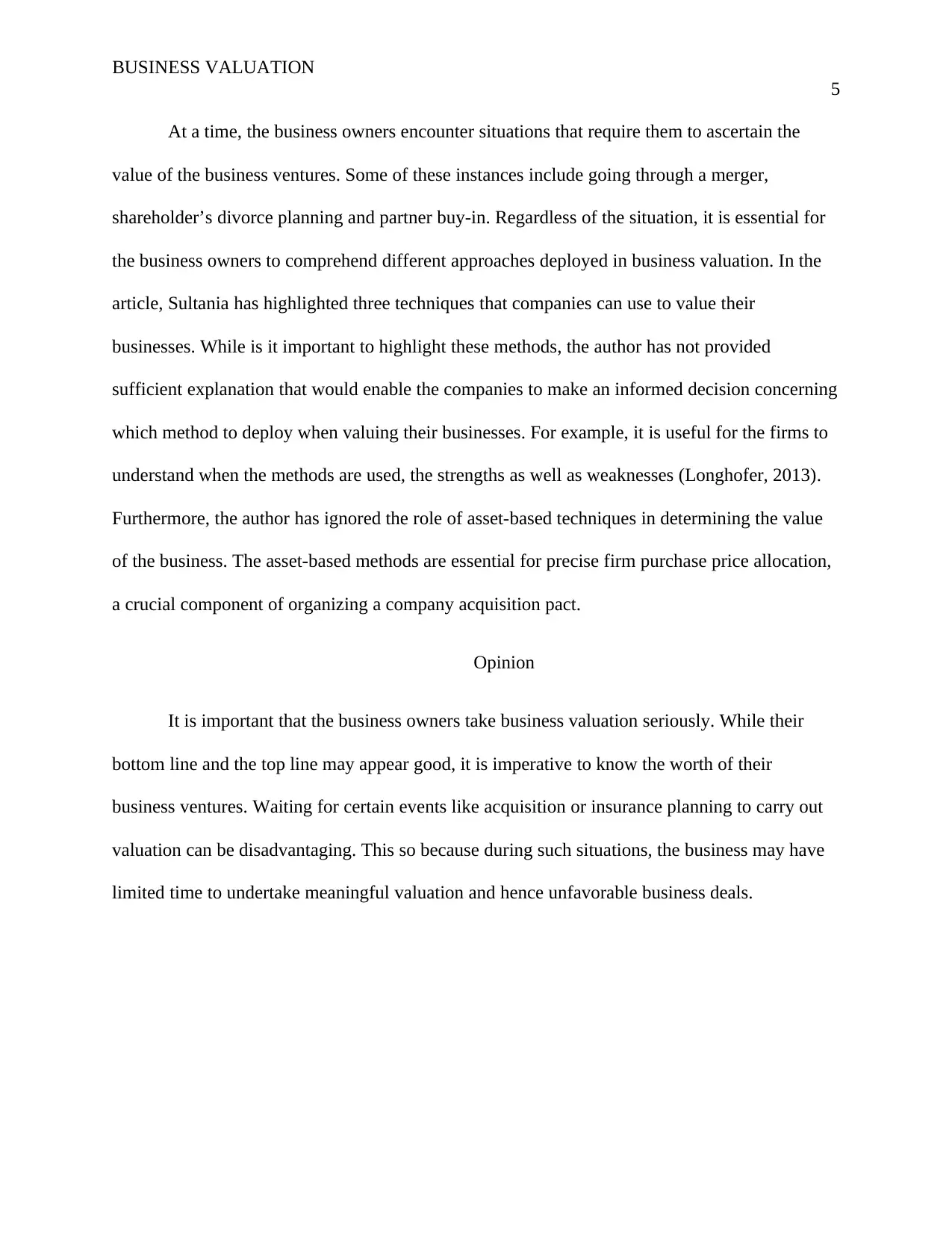
BUSINESS VALUATION
5
At a time, the business owners encounter situations that require them to ascertain the
value of the business ventures. Some of these instances include going through a merger,
shareholder’s divorce planning and partner buy-in. Regardless of the situation, it is essential for
the business owners to comprehend different approaches deployed in business valuation. In the
article, Sultania has highlighted three techniques that companies can use to value their
businesses. While is it important to highlight these methods, the author has not provided
sufficient explanation that would enable the companies to make an informed decision concerning
which method to deploy when valuing their businesses. For example, it is useful for the firms to
understand when the methods are used, the strengths as well as weaknesses (Longhofer, 2013).
Furthermore, the author has ignored the role of asset-based techniques in determining the value
of the business. The asset-based methods are essential for precise firm purchase price allocation,
a crucial component of organizing a company acquisition pact.
Opinion
It is important that the business owners take business valuation seriously. While their
bottom line and the top line may appear good, it is imperative to know the worth of their
business ventures. Waiting for certain events like acquisition or insurance planning to carry out
valuation can be disadvantaging. This so because during such situations, the business may have
limited time to undertake meaningful valuation and hence unfavorable business deals.
5
At a time, the business owners encounter situations that require them to ascertain the
value of the business ventures. Some of these instances include going through a merger,
shareholder’s divorce planning and partner buy-in. Regardless of the situation, it is essential for
the business owners to comprehend different approaches deployed in business valuation. In the
article, Sultania has highlighted three techniques that companies can use to value their
businesses. While is it important to highlight these methods, the author has not provided
sufficient explanation that would enable the companies to make an informed decision concerning
which method to deploy when valuing their businesses. For example, it is useful for the firms to
understand when the methods are used, the strengths as well as weaknesses (Longhofer, 2013).
Furthermore, the author has ignored the role of asset-based techniques in determining the value
of the business. The asset-based methods are essential for precise firm purchase price allocation,
a crucial component of organizing a company acquisition pact.
Opinion
It is important that the business owners take business valuation seriously. While their
bottom line and the top line may appear good, it is imperative to know the worth of their
business ventures. Waiting for certain events like acquisition or insurance planning to carry out
valuation can be disadvantaging. This so because during such situations, the business may have
limited time to undertake meaningful valuation and hence unfavorable business deals.

BUSINESS VALUATION
6
References
Anderson, P. (2013). The Economics of Business Valuation : Towards a Value Functional Approach.
Redwood : Stanford University Press.
Cong, L. W. (2017). Real Options, Business Valuation, and Dynamic Decisions. Journal of Management
Policy & Practice, 18(3), 9-12.
FAZZINI, M. (2017). BUSINESS VALUATION : theory and practice. S.l.: SPRINGER INTERNATIONAL PU.
Greene, D. (2017). Valuations in Corporate Takeovers and Financial Constraints on Private Targets.
Journal of Financial & Quantitative Analysis, 52(4), 1343-1373.
Hood, L. P., & Lee, T. R. (2013). A reviewer's handbook to business valuation : practical guidance to the
use and abuse of a business appraisal. Hoboken, N.J: Wiley.
IYER, R. (2017). SYNERGIES IN BUSINESS VALUATION. CLEAR International Journal of Research in
Commerce & Management, 8(8), 1-4.
Longhofer, R. S. (2013). Business valuation. New York: Law Journal Press.
Nelling, E. (2011). Business valuation demystified. New York : McGraw-Hill.
Sultania, S. (2017, April 19th). Business Valuation Is Not Just A Number, It's A Story . Retrieved April 29th,
2018, from https://www.entrepreneur.com/article/293064
Teo, E. K., Low, B. S., & Doan, J. T. (2017). Business valuation. Singapore : Cengage Learning Asia Pte Ltd.
6
References
Anderson, P. (2013). The Economics of Business Valuation : Towards a Value Functional Approach.
Redwood : Stanford University Press.
Cong, L. W. (2017). Real Options, Business Valuation, and Dynamic Decisions. Journal of Management
Policy & Practice, 18(3), 9-12.
FAZZINI, M. (2017). BUSINESS VALUATION : theory and practice. S.l.: SPRINGER INTERNATIONAL PU.
Greene, D. (2017). Valuations in Corporate Takeovers and Financial Constraints on Private Targets.
Journal of Financial & Quantitative Analysis, 52(4), 1343-1373.
Hood, L. P., & Lee, T. R. (2013). A reviewer's handbook to business valuation : practical guidance to the
use and abuse of a business appraisal. Hoboken, N.J: Wiley.
IYER, R. (2017). SYNERGIES IN BUSINESS VALUATION. CLEAR International Journal of Research in
Commerce & Management, 8(8), 1-4.
Longhofer, R. S. (2013). Business valuation. New York: Law Journal Press.
Nelling, E. (2011). Business valuation demystified. New York : McGraw-Hill.
Sultania, S. (2017, April 19th). Business Valuation Is Not Just A Number, It's A Story . Retrieved April 29th,
2018, from https://www.entrepreneur.com/article/293064
Teo, E. K., Low, B. S., & Doan, J. T. (2017). Business valuation. Singapore : Cengage Learning Asia Pte Ltd.
⊘ This is a preview!⊘
Do you want full access?
Subscribe today to unlock all pages.

Trusted by 1+ million students worldwide

BUSINESS VALUATION
7
7
Paraphrase This Document
Need a fresh take? Get an instant paraphrase of this document with our AI Paraphraser
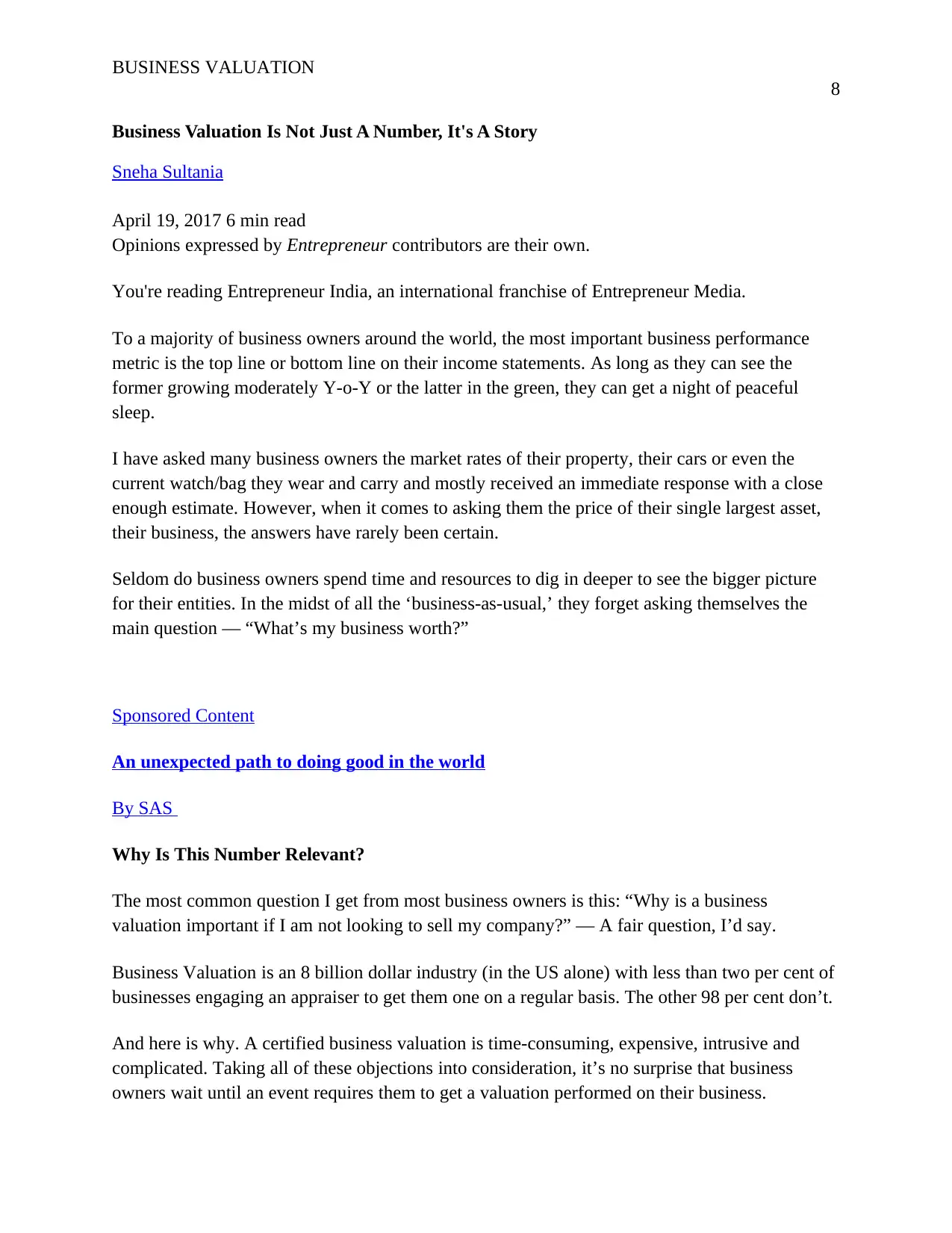
BUSINESS VALUATION
8
Business Valuation Is Not Just A Number, It's A Story
Sneha Sultania
April 19, 2017 6 min read
Opinions expressed by Entrepreneur contributors are their own.
You're reading Entrepreneur India, an international franchise of Entrepreneur Media.
To a majority of business owners around the world, the most important business performance
metric is the top line or bottom line on their income statements. As long as they can see the
former growing moderately Y-o-Y or the latter in the green, they can get a night of peaceful
sleep.
I have asked many business owners the market rates of their property, their cars or even the
current watch/bag they wear and carry and mostly received an immediate response with a close
enough estimate. However, when it comes to asking them the price of their single largest asset,
their business, the answers have rarely been certain.
Seldom do business owners spend time and resources to dig in deeper to see the bigger picture
for their entities. In the midst of all the ‘business-as-usual,’ they forget asking themselves the
main question — “What’s my business worth?”
Sponsored Content
An unexpected path to doing good in the world
By SAS
Why Is This Number Relevant?
The most common question I get from most business owners is this: “Why is a business
valuation important if I am not looking to sell my company?” — A fair question, I’d say.
Business Valuation is an 8 billion dollar industry (in the US alone) with less than two per cent of
businesses engaging an appraiser to get them one on a regular basis. The other 98 per cent don’t.
And here is why. A certified business valuation is time-consuming, expensive, intrusive and
complicated. Taking all of these objections into consideration, it’s no surprise that business
owners wait until an event requires them to get a valuation performed on their business.
8
Business Valuation Is Not Just A Number, It's A Story
Sneha Sultania
April 19, 2017 6 min read
Opinions expressed by Entrepreneur contributors are their own.
You're reading Entrepreneur India, an international franchise of Entrepreneur Media.
To a majority of business owners around the world, the most important business performance
metric is the top line or bottom line on their income statements. As long as they can see the
former growing moderately Y-o-Y or the latter in the green, they can get a night of peaceful
sleep.
I have asked many business owners the market rates of their property, their cars or even the
current watch/bag they wear and carry and mostly received an immediate response with a close
enough estimate. However, when it comes to asking them the price of their single largest asset,
their business, the answers have rarely been certain.
Seldom do business owners spend time and resources to dig in deeper to see the bigger picture
for their entities. In the midst of all the ‘business-as-usual,’ they forget asking themselves the
main question — “What’s my business worth?”
Sponsored Content
An unexpected path to doing good in the world
By SAS
Why Is This Number Relevant?
The most common question I get from most business owners is this: “Why is a business
valuation important if I am not looking to sell my company?” — A fair question, I’d say.
Business Valuation is an 8 billion dollar industry (in the US alone) with less than two per cent of
businesses engaging an appraiser to get them one on a regular basis. The other 98 per cent don’t.
And here is why. A certified business valuation is time-consuming, expensive, intrusive and
complicated. Taking all of these objections into consideration, it’s no surprise that business
owners wait until an event requires them to get a valuation performed on their business.
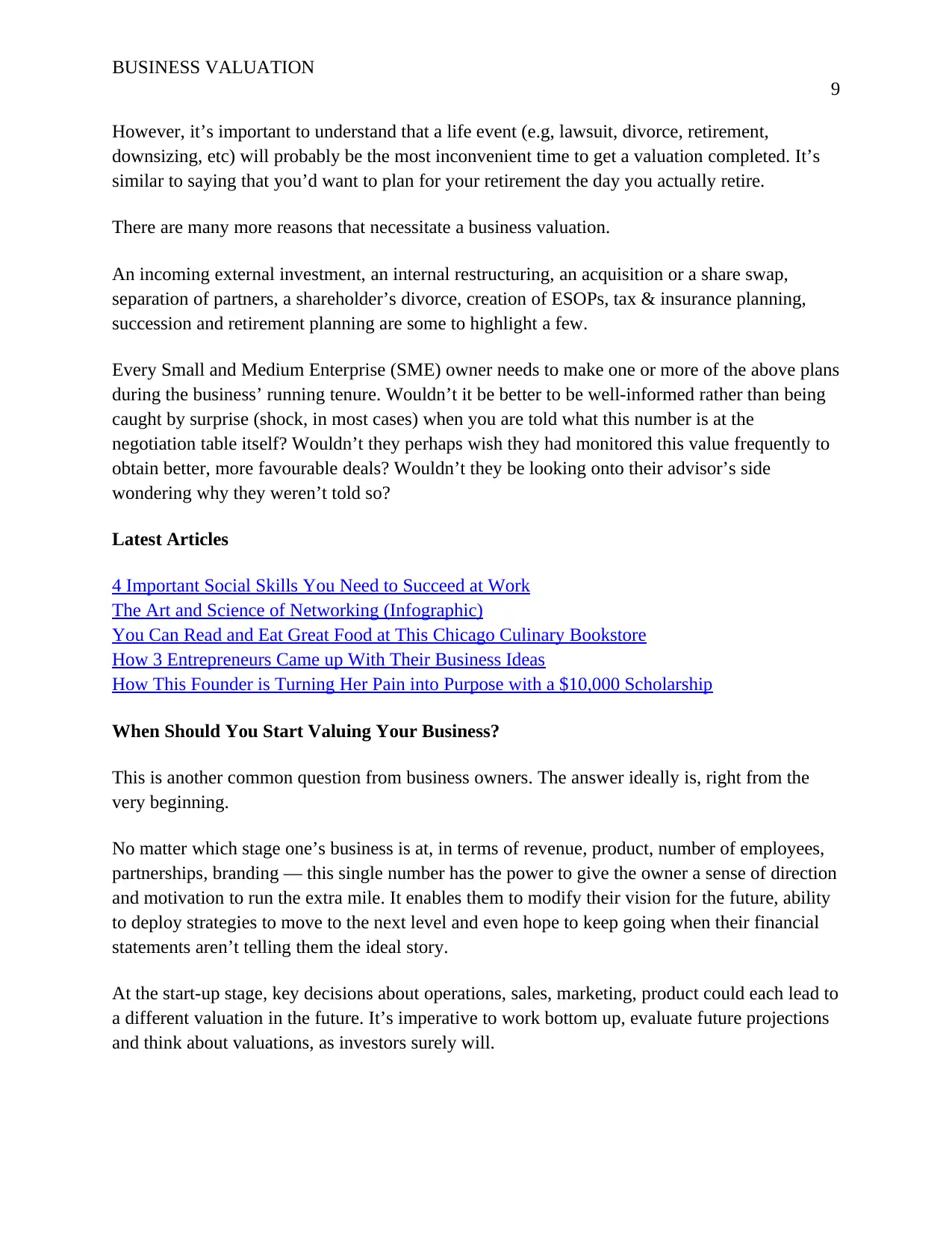
BUSINESS VALUATION
9
However, it’s important to understand that a life event (e.g, lawsuit, divorce, retirement,
downsizing, etc) will probably be the most inconvenient time to get a valuation completed. It’s
similar to saying that you’d want to plan for your retirement the day you actually retire.
There are many more reasons that necessitate a business valuation.
An incoming external investment, an internal restructuring, an acquisition or a share swap,
separation of partners, a shareholder’s divorce, creation of ESOPs, tax & insurance planning,
succession and retirement planning are some to highlight a few.
Every Small and Medium Enterprise (SME) owner needs to make one or more of the above plans
during the business’ running tenure. Wouldn’t it be better to be well-informed rather than being
caught by surprise (shock, in most cases) when you are told what this number is at the
negotiation table itself? Wouldn’t they perhaps wish they had monitored this value frequently to
obtain better, more favourable deals? Wouldn’t they be looking onto their advisor’s side
wondering why they weren’t told so?
Latest Articles
4 Important Social Skills You Need to Succeed at Work
The Art and Science of Networking (Infographic)
You Can Read and Eat Great Food at This Chicago Culinary Bookstore
How 3 Entrepreneurs Came up With Their Business Ideas
How This Founder is Turning Her Pain into Purpose with a $10,000 Scholarship
When Should You Start Valuing Your Business?
This is another common question from business owners. The answer ideally is, right from the
very beginning.
No matter which stage one’s business is at, in terms of revenue, product, number of employees,
partnerships, branding — this single number has the power to give the owner a sense of direction
and motivation to run the extra mile. It enables them to modify their vision for the future, ability
to deploy strategies to move to the next level and even hope to keep going when their financial
statements aren’t telling them the ideal story.
At the start-up stage, key decisions about operations, sales, marketing, product could each lead to
a different valuation in the future. It’s imperative to work bottom up, evaluate future projections
and think about valuations, as investors surely will.
9
However, it’s important to understand that a life event (e.g, lawsuit, divorce, retirement,
downsizing, etc) will probably be the most inconvenient time to get a valuation completed. It’s
similar to saying that you’d want to plan for your retirement the day you actually retire.
There are many more reasons that necessitate a business valuation.
An incoming external investment, an internal restructuring, an acquisition or a share swap,
separation of partners, a shareholder’s divorce, creation of ESOPs, tax & insurance planning,
succession and retirement planning are some to highlight a few.
Every Small and Medium Enterprise (SME) owner needs to make one or more of the above plans
during the business’ running tenure. Wouldn’t it be better to be well-informed rather than being
caught by surprise (shock, in most cases) when you are told what this number is at the
negotiation table itself? Wouldn’t they perhaps wish they had monitored this value frequently to
obtain better, more favourable deals? Wouldn’t they be looking onto their advisor’s side
wondering why they weren’t told so?
Latest Articles
4 Important Social Skills You Need to Succeed at Work
The Art and Science of Networking (Infographic)
You Can Read and Eat Great Food at This Chicago Culinary Bookstore
How 3 Entrepreneurs Came up With Their Business Ideas
How This Founder is Turning Her Pain into Purpose with a $10,000 Scholarship
When Should You Start Valuing Your Business?
This is another common question from business owners. The answer ideally is, right from the
very beginning.
No matter which stage one’s business is at, in terms of revenue, product, number of employees,
partnerships, branding — this single number has the power to give the owner a sense of direction
and motivation to run the extra mile. It enables them to modify their vision for the future, ability
to deploy strategies to move to the next level and even hope to keep going when their financial
statements aren’t telling them the ideal story.
At the start-up stage, key decisions about operations, sales, marketing, product could each lead to
a different valuation in the future. It’s imperative to work bottom up, evaluate future projections
and think about valuations, as investors surely will.
⊘ This is a preview!⊘
Do you want full access?
Subscribe today to unlock all pages.

Trusted by 1+ million students worldwide
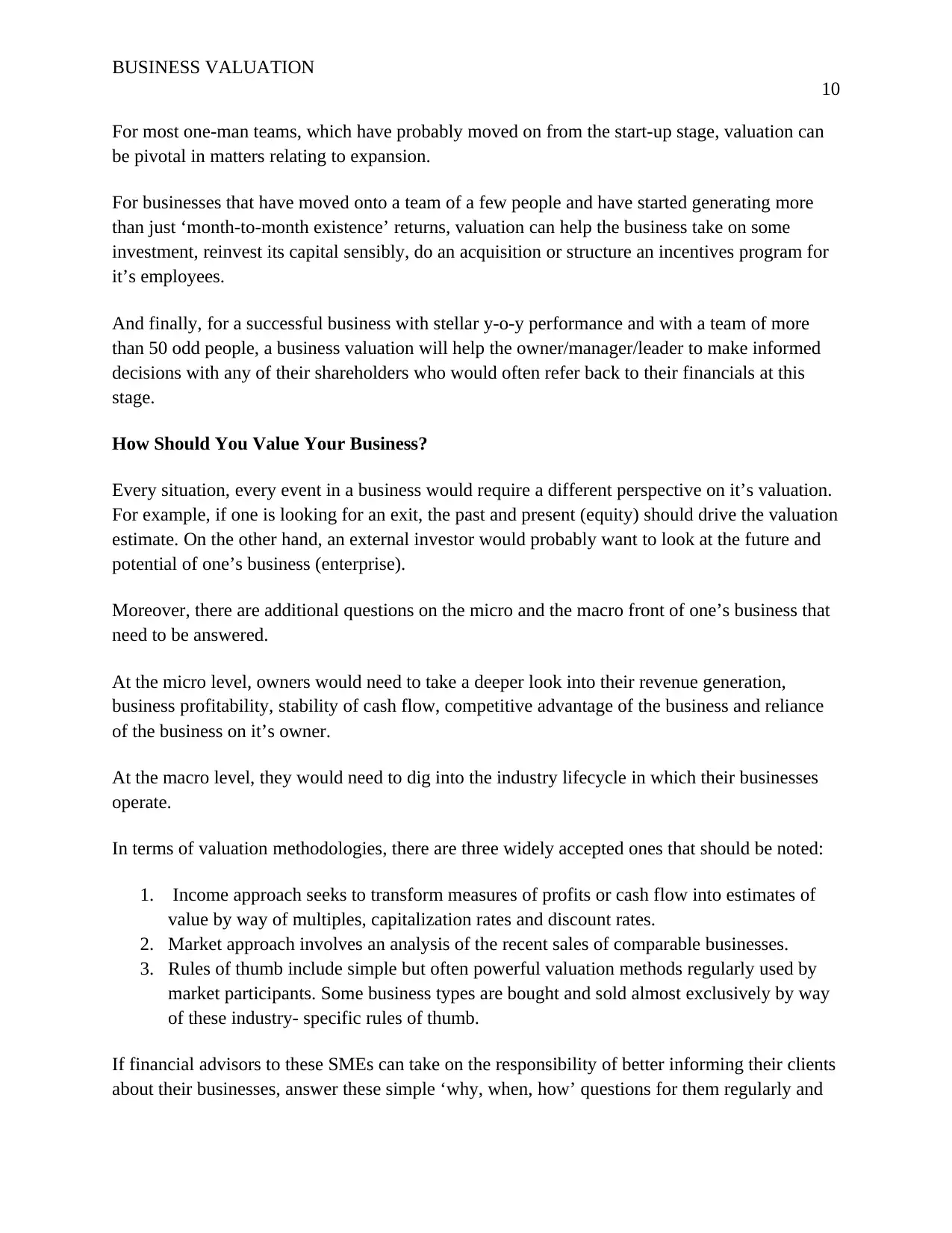
BUSINESS VALUATION
10
For most one-man teams, which have probably moved on from the start-up stage, valuation can
be pivotal in matters relating to expansion.
For businesses that have moved onto a team of a few people and have started generating more
than just ‘month-to-month existence’ returns, valuation can help the business take on some
investment, reinvest its capital sensibly, do an acquisition or structure an incentives program for
it’s employees.
And finally, for a successful business with stellar y-o-y performance and with a team of more
than 50 odd people, a business valuation will help the owner/manager/leader to make informed
decisions with any of their shareholders who would often refer back to their financials at this
stage.
How Should You Value Your Business?
Every situation, every event in a business would require a different perspective on it’s valuation.
For example, if one is looking for an exit, the past and present (equity) should drive the valuation
estimate. On the other hand, an external investor would probably want to look at the future and
potential of one’s business (enterprise).
Moreover, there are additional questions on the micro and the macro front of one’s business that
need to be answered.
At the micro level, owners would need to take a deeper look into their revenue generation,
business profitability, stability of cash flow, competitive advantage of the business and reliance
of the business on it’s owner.
At the macro level, they would need to dig into the industry lifecycle in which their businesses
operate.
In terms of valuation methodologies, there are three widely accepted ones that should be noted:
1. Income approach seeks to transform measures of profits or cash flow into estimates of
value by way of multiples, capitalization rates and discount rates.
2. Market approach involves an analysis of the recent sales of comparable businesses.
3. Rules of thumb include simple but often powerful valuation methods regularly used by
market participants. Some business types are bought and sold almost exclusively by way
of these industry- specific rules of thumb.
If financial advisors to these SMEs can take on the responsibility of better informing their clients
about their businesses, answer these simple ‘why, when, how’ questions for them regularly and
10
For most one-man teams, which have probably moved on from the start-up stage, valuation can
be pivotal in matters relating to expansion.
For businesses that have moved onto a team of a few people and have started generating more
than just ‘month-to-month existence’ returns, valuation can help the business take on some
investment, reinvest its capital sensibly, do an acquisition or structure an incentives program for
it’s employees.
And finally, for a successful business with stellar y-o-y performance and with a team of more
than 50 odd people, a business valuation will help the owner/manager/leader to make informed
decisions with any of their shareholders who would often refer back to their financials at this
stage.
How Should You Value Your Business?
Every situation, every event in a business would require a different perspective on it’s valuation.
For example, if one is looking for an exit, the past and present (equity) should drive the valuation
estimate. On the other hand, an external investor would probably want to look at the future and
potential of one’s business (enterprise).
Moreover, there are additional questions on the micro and the macro front of one’s business that
need to be answered.
At the micro level, owners would need to take a deeper look into their revenue generation,
business profitability, stability of cash flow, competitive advantage of the business and reliance
of the business on it’s owner.
At the macro level, they would need to dig into the industry lifecycle in which their businesses
operate.
In terms of valuation methodologies, there are three widely accepted ones that should be noted:
1. Income approach seeks to transform measures of profits or cash flow into estimates of
value by way of multiples, capitalization rates and discount rates.
2. Market approach involves an analysis of the recent sales of comparable businesses.
3. Rules of thumb include simple but often powerful valuation methods regularly used by
market participants. Some business types are bought and sold almost exclusively by way
of these industry- specific rules of thumb.
If financial advisors to these SMEs can take on the responsibility of better informing their clients
about their businesses, answer these simple ‘why, when, how’ questions for them regularly and
Paraphrase This Document
Need a fresh take? Get an instant paraphrase of this document with our AI Paraphraser

BUSINESS VALUATION
11
get them access to this traditionally expensive metric. We would be able to see SMEs perform
better and maximize value over time.
The Benefits?
To highlight a few: 98% of any economy today is being driven by the performance of SMEs, 7.7
million SMEs are about to change hands in the next 10 years and 7 to10 business owners plan to
fund their retirement with their business’ sale amount.
It’s simple what we at BizEquity are trying to preach: “Knowing the price of one’s business
today can help one modify their strategies, so they can reach the optimum level over time and
narrate a beautiful valuation story for their business tomorrow.”
11
get them access to this traditionally expensive metric. We would be able to see SMEs perform
better and maximize value over time.
The Benefits?
To highlight a few: 98% of any economy today is being driven by the performance of SMEs, 7.7
million SMEs are about to change hands in the next 10 years and 7 to10 business owners plan to
fund their retirement with their business’ sale amount.
It’s simple what we at BizEquity are trying to preach: “Knowing the price of one’s business
today can help one modify their strategies, so they can reach the optimum level over time and
narrate a beautiful valuation story for their business tomorrow.”
1 out of 11
Your All-in-One AI-Powered Toolkit for Academic Success.
+13062052269
info@desklib.com
Available 24*7 on WhatsApp / Email
![[object Object]](/_next/static/media/star-bottom.7253800d.svg)
Unlock your academic potential
Copyright © 2020–2025 A2Z Services. All Rights Reserved. Developed and managed by ZUCOL.

